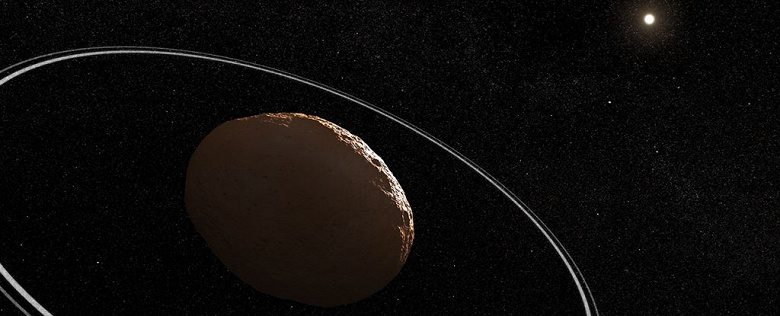Computer models show that just such a tiny moon is capable of preserving the rings of Chariklo
Khariklo — An asteroid-like body with a diameter of only 250 kilometers, which is classified as a “centaur”, moving between Jupiter and Neptune, is a unique object in the solar system. This — the only known «centaur» with rings, and he has not one, but two of them.
How asteroids support their own rings is unknown. But a pair of scientists led by astronomer Amanda Sicafoose of the Planetary Science Institute ran simulations and found that the existence of its own moon may be the most likely explanation for the unique rings.
«Rings around minor planets have only recently been discovered, and only a small number of such systems are currently known. Many studies have been carried out on rings around giant planets, but the mechanisms of ring formation and evolution around small objects are not fully understood. We have shown that one of the possibilities for the existence of thin rings around small bodies — this is their little companion», — says Sicafoose.
Rings in the Solar System — Not unusual. Half the planets — Jupiter, Saturn, Uranus and Neptune, as well as some dwarf planets, have rings made of dust and ice. However, systems with ring structures around minor planets and the presence of moons in these systems are interesting research objects. Recently, astronomers are finding more and more asteroids that have satellites, so small planets with small rings — not the strangest objects. But it is interesting that two very clearly defined rings were discovered at Chariklo.
Through modeling and a series of N-body simulations using a modified code designed to study the rings of Saturn, scientists have found that a small moon with a diameter of only 1 kilometer can maintain its shape and prevent the ring structures from dissipating.
In addition, scientists noticed that the rings are located very close to Chariklo, almost at a distance known as the Roche limit. This is the critical distance at which the rings must begin to stick together under the influence of gravity and form satellites themselves. However, the presence of a small satellite may allow the rings to maintain their shape.
Although the study was a new step in the study of systems like Chariklo, further research requires sending a mission to obtain the necessary confirmatory data. Given Chariklo's remote location and size, observations and photographs cannot be made without research missions. Although there may still be an indirect way to determine if Chariklo has his own moon, which helps control his rings.
The composition of the ring also remains a mystery. Scientists suspect that ice makes up a significant portion of the material, but the exact sizes and interactions of the particles remain unknown. Further studies of the Chariklo system may help unravel these mysteries and provide new data on the formation and development of ring structures.

